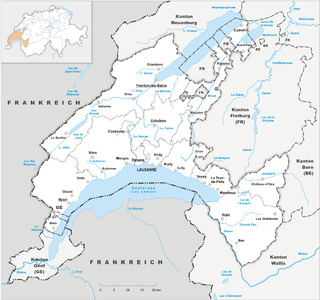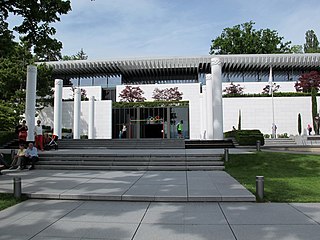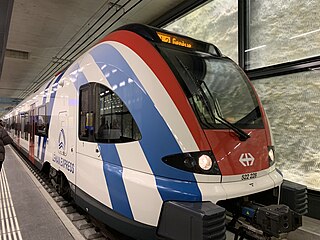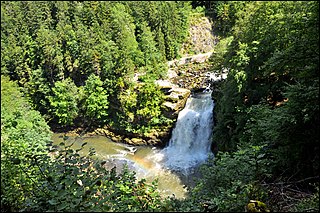



Ouchy is a port and a popular lakeside resort south of the centre of Lausanne in Switzerland, at the edge of Lake Geneva (French : lac Léman).




Ouchy is a port and a popular lakeside resort south of the centre of Lausanne in Switzerland, at the edge of Lake Geneva (French : lac Léman).
Very popular with tourists for the views of nearby France (Évian-les-Bains, Thonon), Ouchy is also a favorite area for rollerskating (Lausanne, and Ouchy in particular, is considered a capital for this sport) and for skateboarding. The incredible views of the lake and the Alps, and the cooler air in summer have made Ouchy a popular place especially in the summer months.
There is a major cluster of hotels – the Beau-Rivage Palace, the Château d'Ouchy, the Mövenpick hotel, etc. – and restaurants around the port. It is served by Lausanne Metro Line 2 from Ouchy station. In 2015, the metro station "Ouchy" was renamed "Ouchy-Olympique" to mark the 100th anniversary of the installation of the International Olympic Committee in Lausanne.
The headquarters of the International Olympic Committee are at Vidy, to the west of Ouchy. The Olympic Museum and the Olympic Park (sculpture garden between the museum and the lake) are in Ouchy.
Once a fishing village, Ouchy was incorporated into the city of Lausanne in the mid-19th century to serve as a port on Lake Geneva.
Links between the port and the city centre were improved in 1877 when Switzerland's first funicular opened. The line was converted to a rack railway in 1954, with a maintenance depot located at the Ouchy station. Eventually renamed Métro Lausanne-Ouchy, the line continued operating until 2006, when it was upgraded to become Lausanne Métro line 2. [1]
On 18 October 1912, the First Treaty of Lausanne was signed in Ouchy between Italy and the Ottoman Empire, concluding the Italo-Turkish War.
FC Stade Lausanne-Ouchy are based in Ouchy. They gained promotion to the second tier of Swiss professional football in 2019. After winning the promotion play-off in 2023, they spent one season in the Swiss Super League, before being relegated again in 2024.
The plot of The Finishing School , a 2004 novel by Scottish author Muriel Spark, is set in 'College Sunrise', a finishing school located in Ouchy. In A Farewell to Arms by Ernest Hemingway, the two main characters, Lt. Frederic Henry and Catherine Barkley, take a cogwheel train into Ouchy to walk along Lake Geneva.

Lausanne is the capital and largest city of the Swiss French-speaking canton of Vaud. It is a hilly city situated on the shores of Lake Geneva, about halfway between the Jura Mountains and the Alps, and facing the French town of Évian-les-Bains across the lake. Lausanne is located 62 kilometres northeast of Geneva, the nearest major city.

Switzerland has a dense network of roads and railways. The Swiss public transport network has a total length of 24,500 kilometres and has more than 2600 stations and stops.

Lake Geneva is a deep lake on the north side of the Alps, shared between Switzerland and France. It is one of the largest lakes in Western Europe and the largest on the course of the Rhône. Sixty percent of the lake belongs to Switzerland and forty percent to France.

Vaud, more formally the Canton of Vaud, is one of the 26 cantons forming the Swiss Confederation. It is composed of ten districts; its capital city is Lausanne. Its coat of arms bears the motto "Liberté et patrie" on a white-green bicolour.

Évian-les-Bains, or simply Évian, is a commune in Eastern France, by the border with Switzerland. It is located in the northern part of the Haute-Savoie department in the Auvergne-Rhône-Alpes region.

Morges is a municipality in the Swiss canton of Vaud and the seat of the district of Morges. It is located on Lake Geneva, west of Lausanne.

The Olympic Museum in Lausanne, Switzerland houses permanent and temporary exhibits relating to sport and the Olympic movement. With more than 10,000 artifacts, the museum is the largest archive of Olympic Games memorabilia in the world and one of Lausanne's prime tourist site draws attracting more than 250,000 visitors each year.

Geneva railway station, also known as Geneva Cornavin railway station, is Geneva's main train station, located in the centre of the city. The immediate area surrounding it is known as Cornavin; both names can be used interchangeably.

The Beau-Rivage Palace is a historical luxury five-star hotel in Lausanne, Switzerland. It is located in Ouchy, on the shores of Lake Léman.

The Métro Lausanne – Ouchy or Métro-Ouchy (LO) was a rack railway which linked the lakeside at Ouchy with Lausanne railway station and the core of the city at Flon. The system also included a parallel line between the railway station and Flon. After closure and modernisation, the line reopened in 2008 as the rubber-tired Line M2 of the Lausanne Metro which included an extension to Épalinges in the north.

The Lausanne Métro system is a two-line urban rail transport system in Lausanne, Vaud, Switzerland. Around a quarter of the system has been used for urban rail transport since 1877, when the route between the city centre and Ouchy opened as Switzerland's first public funicular railway. The network is owned by two distinct companies and operated by a third.

Le Flon is a district of the city of Lausanne, in Switzerland. It is served by Lausanne Métro lines 1 and 2 from Lausanne-Flon station.

The Léman Express is a commuter rail network for the transborder agglomeration of Grand Genève in west Switzerland and the French Alps. Six lines serve Swiss and French towns along 230 km of railway.

Lausanne-Flon is a railway and metro station in the Flon district of central Lausanne, Vaud, Switzerland. It is the hub of the Lausanne Metro system. The station's initial building was also the first in the city to use electricity. A station rebuilding project was the subject of a design competition held in 1988.

Transports publics de la région lausannoise, often abbreviated simply to tl, are the main operator of public transport in Lausanne and the wider agglomeration. As of 2012, TL operates a network of 10 trolleybus routes, 25 conventional bus routes and two métro lines, using more than 290 vehicles. TL operates weekend night services and demand responsive transport.

The France–Switzerland border is 572 km (355 mi) long. Its current path is mostly the product of the Congress of Vienna of 1815, with the accession of Geneva, Neuchâtel and Valais to the Swiss Confederation, but it has since been modified in detail, the last time being in 2002. Although most of the border, marked with border stones, is unguarded, several checkpoints remain staffed, most notably on busy roads.

The Château d'Ouchy is a hotel built on the site of an old medieval castle in Lausanne, Switzerland by fr:Jean-Jacques Mercier between 1889 and 1893.

Vidy is an area of the city of Lausanne (Switzerland), on the shores of Lake Geneva.

Territet (Montreux) is a locality which is part of the Montreux commune, in the Vaud canton, Switzerland.

Lausanne, a city in western Switzerland and a cultural and commercial centre, has returned its tramway as a modern tram system.
![]() Lausanne travel guide from Wikivoyage
Lausanne travel guide from Wikivoyage ![]() Media related to Ouchy at Wikimedia Commons
Media related to Ouchy at Wikimedia Commons